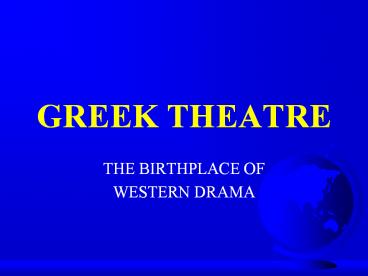GREEK THEATRE - PowerPoint PPT Presentation
1 / 23
Title:
GREEK THEATRE
Description:
... Created Third Actor More concerned with human relationships than religious issues Wrote OEDIPUS THE KING and ANTIGONE EURIPIDES: 480-406 B.C. – PowerPoint PPT presentation
Number of Views:171
Avg rating:3.0/5.0
Title: GREEK THEATRE
1
GREEK THEATRE
- THE BIRTHPLACE OF
- WESTERN DRAMA
2
FESTIVALS OF DIONYSUS
- In honor of the god of Wine and Fertility
- Myths relate to seasonal growing cycles and
passions of Man - Purpose of worship was inducement of fertility
- 8th-7th Century B.C.--contests of choral dancing
held at many festivals dithyrambs
3
DITHYRAMBEcstatic Hymn
- A RELIGIOUS CHANT OR SONG PERFORMED IN RYTHYM AND
WITH DANCING
4
First Definite Record of Drama in Greece 534 B.C.
- City Dionysia (late March) reorganized
- Contest for Best Tragedy instituted
- Winner of first contest is Thespis, who also
acted in the performance - Actors today are known as Thespians, in honor
of the first known Greek actor.
5
HYPOKRITE
- GREEK WORD FOR ACTOR, MEANS WEARER OF MASKS
6
CHORAGUS
- A wealthy patron, wishing to honor the gods, pays
for the cost of a production - Precursor to the Producer
7
GREEK THEATRE STRUCTURES
- Amphitheatres
- Built onto hillsides
- Originally temporary wooden structures, later
made of stone - Were considered a form of temple
- Some held up to 20,000 spectators
8
Parts of a Greek Theatre
- ORKESTRA circular acting space at center,
translates as dancing place - THYMELE Altar stone at center of orkestra
- TEATRON Spectator seating seeing place
- SKENE Stage building behind orkestra where we
get the words scene and scenery
9
Parts of a Greek Theatre
- PARADOS/PARADOI entry ramps for the chorus
between the Teatron and Skene where we get the
word parade - PERIAKTOI Three-sided turnable column used as a
scenic device, placed in space between columns of
skene - MACHINA Crane-like device used to suspend
celestial figures above the action deus ex
machina means god from the machine
10
SKENE
- STAGE HOUSE provides scenic background, a place
to change costumes, place to exit - Had one to three doors
- May have been raised up off ground level
- Developed a second story in later years
11
Side View Orkestra and Teatron
12
Orkestra with Thymele, Skene
13
Teatron
14
AUDITORIUMThe Hearing PlaceIncludes Orkestra
and Teatron
15
Seating for the Priests
16
The Head Priests Chair
17
GREEK PLAYWRIGHTS
- Only 5 playwrights and 45 plays survive
- According to Aristotle, drama developed out of
improvisation by the leaders of the dithyrambs - Early plays, such as those by Thespis, were no
more than a discourse between one actor
(Protagonist) and the chorus. - In later years, playwrights wrote 3 Tragedies and
one Satyr Play for the contests at the City
Dionysia
18
AESCHYLUS 525-456 B.C.
- Tragic Playwright, Introduced Second Actor,
Deuteragonist - Encouraged face-to-face conflict between
characters - reduced importance of chorus, size from 50 to _at_15
- Wrote AGAMEMMNON and PROMETHEUS BOUND
19
SOPHOCLES 496-406 B.C.
- Considered greatest Greek dramatist, wrote
tragedies - Created Third Actor
- More concerned with human relationships than
religious issues - Wrote OEDIPUS THE KING and ANTIGONE
20
EURIPIDES 480-406 B.C.
- Last of great Greek Tragic playwrights
- Reduced chorus to relatively unimportant role
- Treated Gods with lack of awe
- Wrote MEDEA and THE TROJAN WOMEN
21
ARISTOPHANES 450-385 B.C.
- Comic Playwright, Old Comedy, discusses happy
idea - Wrote LYSISTRATA, an anti-war comedy
22
MENANDER 342-292 B.C.
- Comic playwright, New Comedy
- More secular-based, often a comedy of manners
- Copied by the Romans, more like a sitcom
- Wrote ARBITRATION and DYSCOLUS (The Old
Grouch)
23
GREEK TRAGEDIES
- General pattern developed by Aeschylus
- PROLOGOS establishes dramatic situation
- PARODOS Entrance of Chorus, exposition
- EPEISODA main action, equivalent of an Act
- STASIMA Choral interlude, makes comment on the
action in the Epeisoda - Climax occurs in last Epeisoda, so that last
Stasima allows final comment by the chorus - EXODOS Final summation and exit of Chorus























![[PDF] DOWNLOAD How Greek Tragedy Works: A Guide for Director PowerPoint PPT Presentation](https://s3.amazonaws.com/images.powershow.com/10092127.th0.jpg?_=20240803112)






![[PDF] DOWNLOAD The Oxford Companion to Theatre and Performan PowerPoint PPT Presentation](https://s3.amazonaws.com/images.powershow.com/10094014.th0.jpg?_=202408080512)
